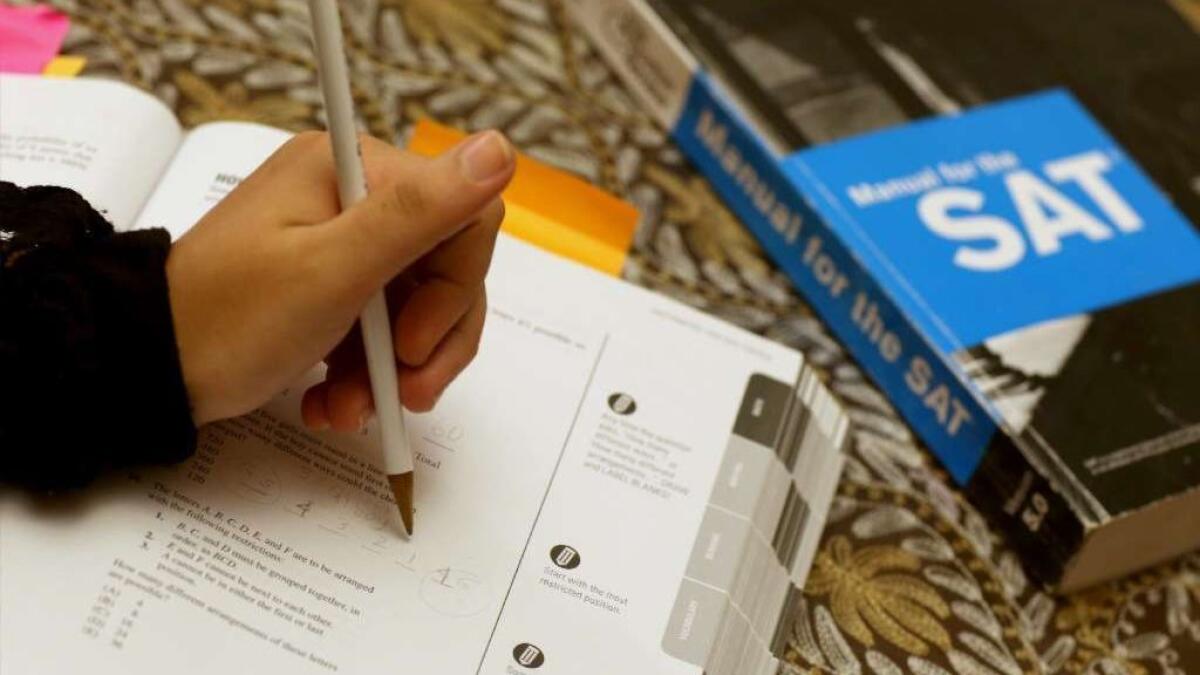Column: SAT’s new adversity score is a desperate, cynical attempt by the College Board to maintain power over college admissions

- Share via
Just when I thought I had gotten all of my pent-up disdain for the SAT out of my system, and I wouldn’t feel compelled to write about it ever again, the College Board goes and makes another boneheaded move.
And now I feel I must weigh in once more.
For those who are unaware of the latest from the standardized testing behemoth, the College Board has announced plans to add an “adversity score” to the SAT college entrance exam results. The new score is intended to be a measure of a student’s socioeconomic status, giving universities a means of figuring an applicant’s background into admissions — decisions.
In announcing the move, Chief Executive David Coleman said the new “Environmental Context Dashboard” — oh my, what a catchy name — “shines a light on students who have demonstrated remarkable resourcefulness to overcome challenges and achieve more with less.”
The scores, ranging from 1 to 100, will be based largely on the characteristics of students’ neighborhoods, including such factors as crime rates, housing stability and the percentage of students eligible for free and discounted school lunch.
It has reportedly been piloted at 50 colleges and universities and will expand to 150 more this fall.
I want to be absolutely clear. Inequality is the biggest, most persistent problem in education and no less than the future of our nation depends on finding smart, aggressive solutions.
If there’s a silver lining to the wide-ranging college admissions scandal orchestrated by a Newport Beach consultant, it’s that it has raised awareness of just how lopsided college admissions are in favor of the affluent.
So I suppose I should grudgingly give the College Board credit for at least trying to do something to balance the scales. But that’s as far as I’m willing to go.
What we don’t need now is gimmicks — superficial marketing ploys that will likely accomplish little and may even make matters worse by creating yet-another-simplistic gauge that can be used to game the system.
I also see the new score as an unintended acknowledgment by the College Board that the SAT has been a failure all along.
A quick history refresher is in order here.
The SAT’s origins date to admissions tests and IQ exams that had surfaced by the end of the 19th century. In the early 20th century the College Board was formed to create a standardized admissions test. Over the decades use of the test grew, and by the 1960s it was commonly utilized by colleges and universities across the country.
It’s important to recognize that throughout its history, the SAT has veered from one stated purpose and format to another, like a drunk driver who can’t figure out which lane to stay in.
It was once administered over several days. It was touted as a measure of knowledge, then as a gauge of inherent intelligence and then back again, and so on. Whole sections have been stripped, and others — like the essay portion — added. It has at times been shown to be racist, and elitist, and attempts to fix these issues have either produced limited progress or introduced more problems.
The latest iteration surfaced three years ago when, under Coleman’s leadership, the old 1,600-point scoring system returned, with an optional essay scored separately, and the bizarre quarter-point deduction for wrong answers was finally scrapped. The reading, writing and math sections were revamped, supposedly to better reflect analytical skills.
Those changes were welcome, but bear in mind that no matter how many times the SAT has been re-imagined, it remains a lousy predictor of future academic success.
Worse still, it’s a giant waste of time and energy for students who actually have some real learning to do — and who are already tested repeatedly. The SAT’s only value is in the misplaced importance it’s given in the college admissions game.
But that might be changing. The rival ACT has chipped away at the SAT’s dominance. And every year, a few more colleges and universities announce that they are dropping the requirement that applicants report scores from either the SAT or the ACT.
So I see this new adversity score as a desperate, cynical attempt by the College Board to stay relevant and maintain its unhealthy power over college admissions.
Adding to the problematic nature of reducing a student’s life to a number on a scale, is that college applicants will never know exactly how their individual index was derived or how they scored. The College Board will only share that information with the institutions to which students apply. So much for transparency.
I’m not alone in thinking this is a bad idea. There are many other critics, such as one who posted on a website about the “whole, new, fresh hell” for students, and an editorial writer who compared the index to the debacle of New Coke.
Perhaps the adversity index will meet the same fate as that hated cola formula and then take the entire SAT down with it. A girl can dream, right?
Addressing the deep inequalities that are baked into our educational system requires comprehensive reform and hard work. Relying on a single score to level the playing field is just an easy out, and that’s a path we’ve already taken for far too long.
Patrice Apodaca is a former Los Angeles Times staff writer, and is the coauthor of “A Boy Named Courage: A Surgeon’s Memoir of Apartheid.” She lives in Newport Beach.
All the latest on Orange County from Orange County.
Get our free TimesOC newsletter.
You may occasionally receive promotional content from the Daily Pilot.




